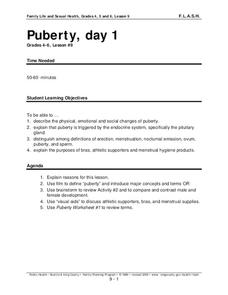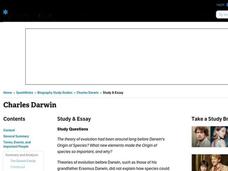American Psychological Association
Developing Adolescents
Why to young people act the way they do? Scholars investigate the stages of adolescent development incorporating high school psychology techniques. Using research from the American Psychological Association, they uncover the five areas...
Curated OER
Rates of Puberty Change
Eighth graders investigate the reasons for why individuals go through puberty at different times and rates. They conduct a personal worth role play to encourage diversity and self-acceptance. Group discussion is used for scaffolding the...
Curated OER
What's important? Knowing your facts, yourself and your role models
Third graders review safety rules about alcohol, tobacco and medicines. They learn healthy alternatives to using alcohol, tobacco and medicines. They recognize healthy and unhealthy choices
Curated OER
Sexual Development
Pupils identify what puberty is and what changes they can expect during this period of time. Students discuss the challenging aspects of puberty and celebrate the best and most exciting aspects. Pupils record the best/easiest things...
Curated OER
Theatre Lesson Plan
Second graders complete pantomime and improvisational theatre activities. In this theatre lesson, 2nd graders play a 'sound ball' game and recreate sounds as they toss the ball. Students discuss projection for an actor and practice the...
Curated OER
Growing in Communities, Kids on the Grow
Students participate in an after school program that promotes concern for others, recognizing differences, accepting differences, leadership roles, mentoring, self-responsibility and personal safety. They explore the diversity of their...
Curated OER
Puberty
Students investigate life science by answering maturity questions. In this human health lesson, students identify the changes which occur during puberty and answer study questions based on sexual awareness. Students define scientific...
Curated OER
Character Education: Responsibility
Young scholars study Manuel de Zavala and his role in the history of Texas. In this character education lesson, students read about Manuel Lorenzo and underline the responsibilities he took on in his life. Young scholars then answer...
Curated OER
Grow Your Character Bookmarks
Students make bookmarks out of seed paper to study the growth of seeds and complete an activity for the Six Pillars of Character. In this science and character instructional activity, students describe the stages of growth of plants and...
Health Smart Virginia
Walk A Mile in Their Shoes
After watching a presentation that describes the difference between sympathy and empathy, class members fill out an empathy shoe organizer sharing 10 facts about themselves that others may not know. The goal is to create a more accepting...
K12 Reader
Community Connections
Who helps our community run smoothly? Read a short passage about community members and helpers. After kids finish the passage, they answer five short questions on the other side of the page.
California Department of Education
Hitting the Write Note: Writing a Proposal
To whom it may concern ... Scholars undergo the process of writing a letter to an authority figure. The activity asks writers to compose a formal letter requesting a music therapy space. Pupils learn how to submit a project proposal to...
Nemours KidsHealth
Diabetes: Grades 6-8
After reading a series of articles that provide background information about Type 1 and Type 2 diabetes, class members design a meal plan and an activity plan for a weeklong summer camp for 5- to 8-year olds with diabetes. A second...
Health Smart Virginia
How the Namuhs Learned to be Content with Who They Are
The Namuhs have a lot to teach humans how idealized images presented in advertising can impact self-perception and self-worth. After brainstorming 10 traits the media sets as the perfect body, class members read a short story about the...
Health Smart Virginia
Suicide Prevention: Finding the Words
Provide young people with the information they need to identify the warning signs for depression and the risk factors for suicide. The lesson helps high schoolers learn positive coping skills, role-play how to support friends who may be...
Health Smart Virginia
Fitting In and Setting Healthy Boundaries
Saying "No" isn't easy. Setting healthy boundaries and sticking to them takes practice. A series of exercises enables sophomores to practice these skills and reflect on the difference between fitting in and belonging.
Florida Department of Health
Exploring Healthy Relationships Unit
A four-lesson unit on healthy relationships begins by helping individuals develop a positive sense of self-worth by identifying their own positive characteristics. Participants also examine data from the YRBS Online Tool about the...
Curated OER
Food and Your Body -- How to Maintain a Healthy Diet
Students examine the different food groups on the food pyramid. In groups, they discover the proper amount to eat from each food group and how to prepare healthy meals. They keep a food journal and calculate the amount of calories they...
Curated OER
Anger (Part 1): Identifying Our Style
Students identify the two common sources of anger. For this psychology lesson, students discuss productive ways to express anger. They complete a reflection worksheet at the end of the lesson.
Curated OER
A Thousand Words
Students demonstrate compassion for others. In this character education lesson, students view photos from magazines and interpret what they see. Students discuss the feelings they get when viewing the photos.
Curated OER
Charles Darwin
In this online interactive history activity, high schoolers respond to 9 short answer and essay questions about Charles Darwin. Students may check some of their answers on the interactive activity.
Curated OER
Playground Safety
Students conduct experiments with fruit falling from playground equipment to explain the effects of falling off playground equipment.
Curated OER
Growing With Others, Kids on the Grow!
Students participate in an after school program that promotes accepting differences, self-motivation, teamwork, leadership roles, personal safety and self-responsibility, family unity and recognizing the characteristics of good...

























